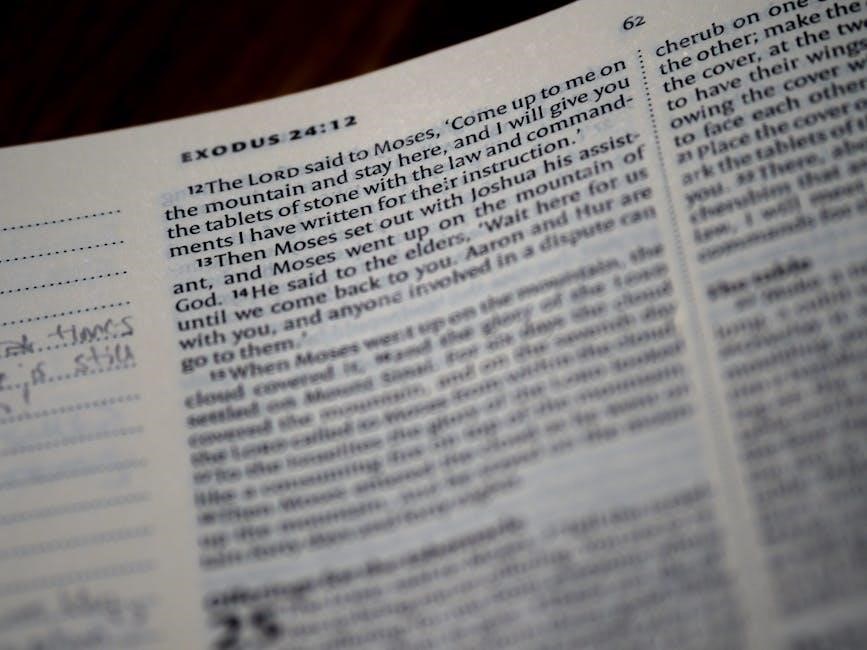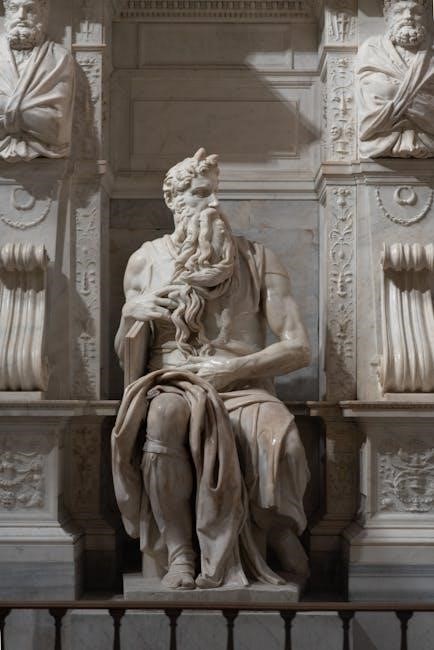the assumption of moses pdf

The Assumption of Moses is a significant apocryphal text, part of Jewish apocalyptic literature, exploring Moses’ life, eschatology, and divine judgment. Its PDF versions, including critical editions by scholars like Johannes Tromp, provide accessible resources for studying this ancient work, offering insights into its historical and theological significance.
Background and Significance of the Assumption of Moses
The Assumption of Moses is a Jewish apocalyptic text, historically significant for its messianic themes and eschatological insights. It disappeared by the 13th century, surviving in fragments and later translations, influencing early Christian thought and remaining a vital resource for scholarly study in PDF formats.
2.1 Historical Context and Origins
The Assumption of Moses is an ancient Jewish apocalyptic text, likely written around 10 AD, as it anticipates the Messiah’s arrival shortly after Herod the Great’s death in 29 AD. Unlike the Seder Olam, which expected the Messiah in 70 AD, this text places the messianic event earlier. The work disappeared by the 13th century, surviving only in fragments and a Latin manuscript from the 6th century. Its origins are tied to Jewish apocalyptic traditions, influencing early Christian thought. Scholars like R;H. Charles and Johannes Tromp have produced critical editions, with PDF versions available for study. These editions provide insights into its historical context, linguistic style, and theological themes, making it a vital resource for understanding 1st-century Jewish eschatology and messianic expectations.
2.2 Religious and Cultural Importance
The Assumption of Moses holds significant religious and cultural value as a Jewish apocalyptic text, influencing early Christian thought and eschatology. It explores themes like messianic expectations, divine judgment, and Moses’ role as a prophetic figure. The text’s disappearance by the 13th century and its survival in fragments and a 6th-century Latin manuscript underscore its historical importance. Scholars like R.H. Charles and Johannes Tromp have produced critical editions, making it accessible in PDF formats. These resources highlight its theological depth and linguistic style, offering insights into 1st-century Jewish beliefs. The text’s themes of redemption and divine justice resonate across religious traditions, making it a vital study for understanding ancient Jewish and Christian thought. Its availability in digital formats ensures its continued relevance for modern scholarship and religious study.
Composition and Structure of the Text
The Assumption of Moses is a 1st-century Jewish apocalyptic text, exploring Moses’ life and eschatology. Its fragmented structure is preserved in critical PDF editions with scholarly commentary and analysis.
3.1 Authorship and Dating

The Assumption of Moses is a pseudonymous text, traditionally attributed to Moses but likely written by an unknown Jewish author. Scholars date it to the 1st century CE, possibly between 4 BCE and 30 CE, based on its messianic expectations and historical references. The text reflects a post-Herodian context, aligning with the belief in a Messiah appearing shortly after Herod’s rule. While the exact author remains unknown, its style and content suggest a Jewish apocalyptic tradition. Critical editions, such as those by R.H. Charles and Johannes Tromp, provide insights into its composition and historical background. These scholars emphasize the text’s significance in understanding early Jewish eschatology and its influence on later religious thought. The PDF versions of these editions offer accessible resources for studying the text’s authorship and dating.
3.2 The Structure of the Assumption of Moses

The Assumption of Moses is structured into distinct sections, focusing on Moses’ life, eschatological visions, and divine judgment. The text begins with Moses transferring leadership to Joshua and concludes with Moses’ death and ascension. It includes a review of Israel’s history, a detailed apocalypse, and a theological reflection on God’s justice. The surviving fragments, primarily from a 6th-century Latin manuscript, reveal a coherent narrative flow. Critical editions, such as Johannes Tromp’s, provide a structured analysis, highlighting the text’s apocalyptic themes and messianic expectations. The PDF versions of these editions offer scholars and readers a well-organized format to explore the text’s composition and theological insights, making it easier to study its historical and religious significance. This structure underscores the text’s importance in Jewish apocalyptic literature and its influence on early Christian thought.
3.3 Language and Style
The Assumption of Moses is written in a style characteristic of Jewish apocalyptic literature, with vivid imagery and symbolic language. The surviving Latin text, likely translated from a Greek original, features dramatic dialogues and prophetic visions. Scholars like R.H. Charles and Johannes Tromp have noted its rhetorical flourishes, emphasizing divine justice and eschatological themes. The language is often poetic, with a focus on theological and moral instruction. Critical editions, such as Tromp’s, highlight the text’s linguistic nuances, while PDF versions provide accessible formats for studying its style and structure. The text’s apocalyptic tone and messianic expectations are central to its narrative, making it a rich resource for understanding early Jewish theology and its influence on Christian thought. Its language and style remain a focal point for scholarly analysis and interpretation.

Key Themes and Content
The Assumption of Moses explores messianic expectations, Moses’ role, and divine judgment, offering insights into Jewish apocalyptic thought and eschatology through vivid imagery and prophetic visions.
4.1 Messianic Expectations and Eschatology
The Assumption of Moses delves into messianic expectations, anticipating a divine savior to redeem Israel. It predicts the Messiah’s arrival shortly after Herod the Great’s reign, around 29 AD, aligning with Jewish apocalyptic hopes. The text vividly describes eschatological events, including divine judgment and the ultimate triumph of righteousness. These themes resonate with broader Jewish apocalyptic literature, emphasizing a future age of peace and justice. The Messiah’s role is central, portrayed as a deliverer who ushers in a new era, reflecting the text’s theological focus on redemption and the culmination of history. This eschatological vision remains a cornerstone of its religious and cultural significance, offering profound insights into early Jewish messianic thought.
4;2 The Role of Moses in the Text
Moses is central to the narrative, portrayed as a leader, prophet, and intercessor for Israel. The text highlights his divine commission and the transfer of leadership to Joshua. A pivotal scene describes a dispute between Michael the archangel and the devil over Moses’ body, symbolizing the struggle between good and evil. Moses’ death and assumption into heaven emphasize his unique role as a mediator between God and humanity. The text underscores his importance in Jewish tradition, blending historical and apocalyptic elements. Moses’ legacy is framed as a precursor to future redemption, aligning with broader messianic and eschatological themes. His role reinforces the text’s theological message of divine justice and the ultimate triumph of righteousness.
4.3 The Concept of Divine Judgment
The Assumption of Moses emphasizes divine judgment as a central theme, portraying it as a time of reckoning for individuals and nations. The text highlights God’s justice, with rewards for the righteous and punishment for the wicked. It aligns with Jewish apocalyptic traditions, envisioning a messianic era where divine judgment ushers in a new order. The Messiah’s role is pivotal, as he executes God’s judgment, purifying Israel and establishing righteousness. The text also reflects on the destruction of the wicked, including oppressive rulers, and the ultimate triumph of God’s people. This eschatological vision underscores moral accountability and the inevitability of divine retribution, reinforcing ethical living and faith in God’s sovereignty. The concept of judgment serves as a theological framework for understanding history and the future, resonating with broader Jewish and Christian apocalyptic thought.

Historical and Cultural Context
The Assumption of Moses reflects Jewish apocalyptic traditions, influenced by historical events like Herod the Great’s reign and early Christian thought, shaping its theological and cultural significance.
5.1 The Assumption of Moses in Jewish Apocalyptic Literature

The Assumption of Moses is a pivotal text within Jewish apocalyptic literature, reflecting themes of messianic expectation and eschatology. It aligns with works like the Testament of Moses, emphasizing divine judgment and redemption. The text is unique in its focus on Moses’ role as a messianic figure, contrasting with other apocalyptic writings that often center on prophetic or patriarchal figures. Its historical context, likely written around the 1st century CE, places it amid significant political and religious upheaval, such as the reign of Herod the Great and the subsequent expectations of messianic deliverance. The Assumption of Moses also diverges from works like the Seder Olam by predicting the Messiah’s arrival earlier, shortly after Herod’s death, rather than linking it to the destruction of the Temple in 70 AD. This text, available in PDF formats like Johannes Tromp’s critical edition, offers scholars a window into Jewish theological and cultural thought during a transformative period.
5.2 The Influence of Early Christian Thought

The Assumption of Moses has left a noticeable imprint on early Christian thought, particularly in its apocalyptic and theological themes. Early Christian texts, such as the Book of Jude, reflect similar motifs, like the dispute between Michael the archangel and the devil, which parallels themes in the Assumption of Moses. This overlap suggests that early Christian writers drew inspiration from Jewish apocalyptic literature. Scholars like R.H. Charles have highlighted these connections, noting how the text’s eschatological visions influenced Christian understandings of divine judgment and messianic expectations. The Assumption of Moses, available in PDF formats, remains a vital resource for studying these cross-cultural theological exchanges. Its influence underscores the shared religious and cultural heritage between Jewish and early Christian traditions, offering insights into the evolution of apocalyptic thought in the ancient world.
Scholarly Analysis and Interpretations
Scholars like Johannes Tromp and R.H. Charles have produced critical editions and translations of the Assumption of Moses, offering deep insights into its theological and historical context. Their work, available in PDF formats, has sparked debates about its authorship, dating, and cultural significance, while modern scholars continue to explore its relevance in understanding ancient Jewish and Christian thought.
6.1 Critical Editions and Translations
The Assumption of Moses has been meticulously studied through critical editions and translations, with scholars like Johannes Tromp and R.H. Charles contributing significantly. Tromp’s critical edition, available as a PDF, includes a detailed commentary, offering insights into the text’s structure and historical context. Charles’s 1897 English translation, derived from a sixth-century Latin manuscript, remains a foundational resource. These editions often present the text in its original and restored forms, allowing scholars to analyze linguistic and theological nuances. The Latin manuscript, preserved in Milan, serves as a primary source for these translations. Digital versions of these works, including PDF formats, have made them accessible to a broader audience, facilitating further research and interpretation. These critical editions are essential for understanding the text’s complexities and its place in Jewish apocalyptic literature.
6.2 Theological Debates and Controversies
The Assumption of Moses has sparked significant theological debates, particularly regarding its portrayal of Moses, divine judgment, and messianic expectations. Scholars debate the text’s view of Moses as a messianic figure versus a prophetic leader, with some arguing it reflects early Jewish messianic ideals. The text’s depiction of Michael the archangel disputing with the devil over Moses’ body has also fueled discussions about the nature of divine justice and the afterlife. Additionally, the absence of a clear messiah figure in some interpretations has led to controversies about its eschatological framework. Theological debates further extend to its influence on early Christian thought, particularly in texts like the Epistle of Jude. These discussions highlight the text’s complexity and its role in shaping religious ideologies, making it a focal point of scholarly analysis in PDF resources and theological studies.

6.3 Modern Scholarly Perspectives
Modern scholars approach the Assumption of Moses with interdisciplinary methodologies, integrating historical, literary, and theological analyses. Recent studies emphasize the text’s role in Jewish apocalyptic literature, exploring its messianic themes and eschatological visions. Digital resources, such as PDF editions by Johannes Tromp and R.H. Charles, have facilitated access to critical translations and commentaries, enabling deeper textual analysis. Scholars also examine the text’s influence on early Christian thought, particularly in its portrayal of divine judgment and the afterlife. Advances in digital scholarship have further enhanced understanding, with online archives providing comparative studies and theological debates. These modern perspectives highlight the text’s enduring relevance, offering fresh insights into its historical context and religious significance. The availability of these resources in PDF format has democratized access, fostering a broader academic and public engagement with the Assumption of Moses.

Digital Availability and Access
The Assumption of Moses is widely available in PDF format, with critical editions by scholars like Johannes Tromp and R.H. Charles offering detailed commentary and analysis online.

7.1 The Assumption of Moses in PDF Format
The Assumption of Moses is readily available in PDF format, offering convenient access to this ancient text. Critical editions, such as Johannes Tromp’s The Assumption of Moses: A Critical Edition With Commentary, provide scholarly insights and translations. These PDFs are accessible through various online platforms, including academic repositories and digital libraries. R.H. Charles’s 1897 translation is also available in PDF, featuring the unemended and critically emended Latin text from a sixth-century manuscript. Additionally, platforms like Google Books and online archives host PDF versions, making the text widely accessible for research and study. These digital resources are invaluable for scholars and enthusiasts alike, providing a comprehensive understanding of the text’s historical and theological significance.
7.2 Online Archives and Repositories
Online archives and repositories provide extensive access to The Assumption of Moses in digital formats. Platforms like Google Books and academic databases host PDF versions of critical editions, such as Johannes Tromp’s The Assumption of Moses: A Critical Edition With Commentary. These repositories also include R.H. Charles’s 1897 translation, featuring the unemended and critically emended Latin text from a sixth-century manuscript. Additionally, online libraries offer free downloads of the text in PDF and other formats, making it accessible for global scholarship. These digital archives are essential for researchers, providing easy access to historical and theological analyses. They also include metadata about the original manuscripts and their digitization processes, ensuring transparency and authenticity. Such resources are invaluable for studying this ancient apocalyptic text and its cultural significance.
The Assumption of Moses remains a vital text for understanding Jewish apocalyptic thought and early Christian influences. Its availability in PDF format, including critical editions by scholars like R.H. Charles and Johannes Tromp, ensures accessibility for modern research. These digital versions, often accompanied by commentary and historical context, highlight the text’s theological significance, particularly its themes of messianic expectations and divine judgment. Online archives and repositories have made it easier for scholars and enthusiasts to explore this ancient work, preserving its legacy for future generations. The Assumption of Moses continues to be a cornerstone in the study of apocalyptic literature, offering insights into the cultural and religious dynamics of its time.